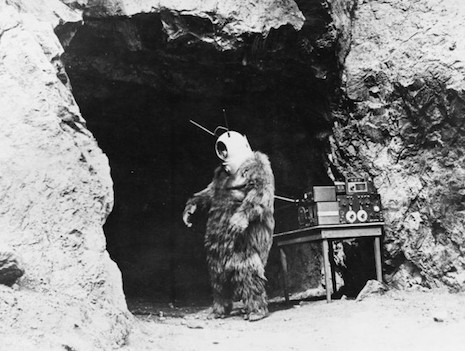
“At what point on the graph do ‘must’ and ‘cannot’ meet?”
KDOC, the Orange County station that broadcast Wally George’s The Hot Seat, was also home to a wonderful show with even lower production values than Wally’s called Request Video. After school, I would rush to the TV to watch Request Video, hoping to catch another glimpse of the Ramones.
The Cramps paid a visit to Request Video before one of their early 90s shows at the Hollywood Palladium, and their wide-ranging discussion with host Gia DeSantis touched on many things that are still of vital importance to your life, such as the size of Lux’s pumps, the band’s makeup tips, and Lux and Ivy’s favorite B movies. While Ivy picked the classic Gun Crazy, Lux named this appalling 1953 movie about a robot from the moon who looks like a gorilla wearing a diver’s helmet. Its mission, to exterminate all human beings on Earth, doesn’t sound like such a bad idea after you’ve spent a few minutes with the cast.

Lux expanded on his love for Robot Monster in a 1995 interview with Phoenix New Times:
“I’m interested in Jungian archetypes, what it is that makes people want to see movies about flying saucers and alien invasions. I’m interested why someone would write a film like Robot Monster [a notoriously bad Fifties piece featuring a monster that was essentially a gorilla with a deep-sea-diving helmet for a head]. And why a lot of people would write films that have so much in common—Robot Monster, Plan 9 From Outer Space, you name it, all those old horror movies.
“I think it has something to do with the collective unconscious. I feel like watching these films to be just like dream interpretations. When I see an old horror movie, it really strikes a chord in me, and it’s because I’m connected to the same thing that the person who wrote the movie is connected to.”
Lux pauses briefly, then provides a summation: “I think the reason I do things is a lot like the same reason Johnny Rotten did what he did, or the same reason Marcel Duchamp did the things he did. We’re all connected together in one aspect of consciousness.”

Ro-Man’s hideout in Griffith Park
Screenwriter Wyott Ordung talks about working on Robot Monster in the book 3-D Revolution: The History of Modern Stereoscopic Cinema. Though he doesn’t shed much light on Lux’s concerns, he does relate that the movie’s reception nearly proved fatal for him and director Phil Tucker:
When I went to see the picture, I was sitting in the Hollywood Paramount [theater]. It’s funny now—it wasn’t funny then—and as I’m walking out of the theater the manager of the popcorn stand says “We should skin the writer alive.” [...] The next thing I know Phil Tucker tried to commit suicide. There was a picture of him in the Los Angeles Mirror on the front page. He was lying there clutching the cans of film. Was it because of the film? I think he wanted publicity. That’s what I think. Young genius thinks he made a great picture for $45,000. People are not going to the movie and so on and he ended up in Camarillo [State Mental Hospital].
It’s unlikely that you’ll be placed on suicide watch after seeing Robot Monster, but chances are good that you will spend the next 24 to 48 hours mimicking the booming monotone of the movie’s villain, Ro-Man. Try it out at the drug store or the gas station. “YOUR DEATHS WILL BE INDESCRIBABLE. FOOL HU-MANS! THERE IS NO ESCAPE!”
There is a tenuous connection to rockabilly that may have interested Lux. Tucker’s short film Stardust in Your Eyes, a 3-D showcase for the talents of one Slick Slavin, was intended to introduce Robot Monster in theaters. Slavin (né Trustin Howard) later recorded two rockabilly songs, “Speed Crazy” and “Ghost Town Rock,” for 1959’s Speed Crazy.